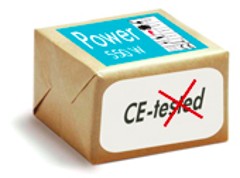What does"CE-tested" mean?

The CE mark is not an advertising logo
Source: © DGUV Test
A whole series of European directives specify that only products with CE marking may be sold. The task of applying the CE mark always lies with the manufacturer (or the manufacturer’s authorised representative or the importer if the manufacturer is not based in the European Economic Area).
Compulsory testing by a neutral testing body is only stipulated for some products. There is no testing obligation for electrical appliances and simple machinery, which account for a very large share of CE products.
However, any manufacturer can have its products tested voluntarily at its own discretion. The best-known certification mark that the product can then be awarded is the GS mark (GS stands for "Geprüfte Sicherheit", which means "tested safety"). Naturally, these tests also check whether the EC directives have been complied with. Some testing bodies also offer testing without certification marks, e.g. tests to determine whether the safety regulations have been adhered to. However, these tests are normally not described as "CE testing".
What is the purpose of CE marking?
CE marking is not an advertising logo. It is legally required on all products covered by a European directive requiring CE marking.
It can only be awarded for products designed and manufactured in line with the valid safety and health requirements. The manufacturer must ensure that this is the case and, if necessary, conduct the appropriate testing. This "CE testing" is a very responsible task for manufacturers.
"CE-tested" does not convey an advertising message – unlike voluntary certification marks. Marks such as the GS-mark or the DGUV Test mark are awarded by independent testing bodies following comprehensive testing. Advertising using the latter types of mark indicates that the manufacturer has done more than necessary to ensure that the product it places on the market is safe and health-friendly.
More information on CE marking

- Comparison of the CE mark and certification marks (DGUV Test information sheet No 3)
Contact
Alte Heerstraße 111
53757 Sankt Augustin
Tel: +49 30 13001-4566
Fax: +49 30 13001-864566